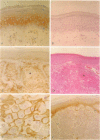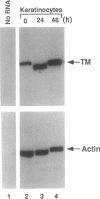Abstract
Thrombomodulin is an endothelial cell surface glycoprotein that inhibits the procoagulant activities of thrombin and accelerates activation of the anticoagulant protein C. Because protein C deficiency is associated with cutaneous thrombosis, we investigated the expression of thrombomodulin in human skin. Thrombomodulin was detected by immunohistochemical staining both in dermal endothelial cells and in epidermal keratinocytes. Within the epidermis, thrombomodulin staining was limited to keratinocytes of the spinous layer, suggesting that thrombomodulin is induced when basal keratinocytes begin to terminally differentiate. Thrombomodulin expression also correlated with squamous differentiation in epidermal malignancies; little or no thrombomodulin staining was seen in five basal cell carcinomas, whereas strong thrombomodulin staining was observed in each of five squamous cell carcinomas. Human foreskin keratinocytes cultured in medium containing 0.07 mM calcium chloride synthesized functional thrombomodulin with cofactor activity comparable to thrombomodulin in human umbilical vein endothelial cells. Stimulation of keratinocyte differentiation with 1.4 mM calcium chloride for 48 h produced 3.5-, 3.2-, and 5.6-fold increases in thrombomodulin cofactor activity, antigen, and mRNA, respectively. These observations suggest that thrombin is regulated by keratinocyte thrombomodulin at sites of cutaneous injury, and indicate a potential role for thrombomodulin in epidermal differentiation.
Full text
PDF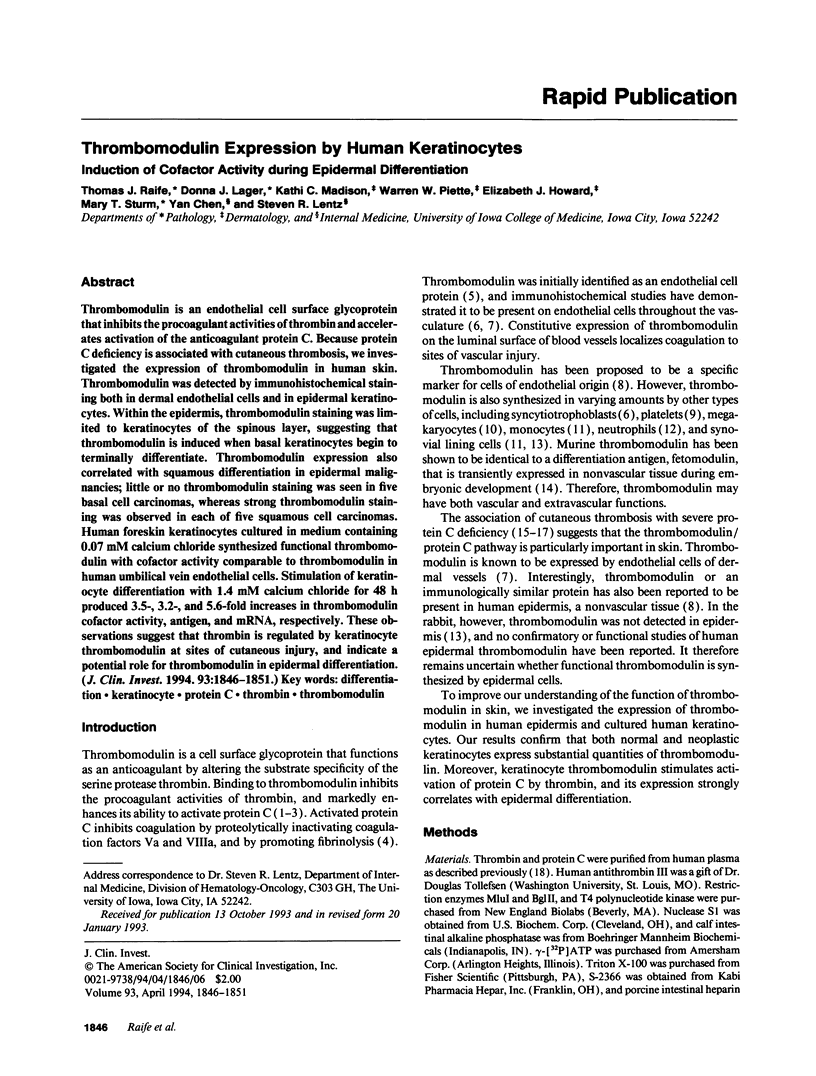
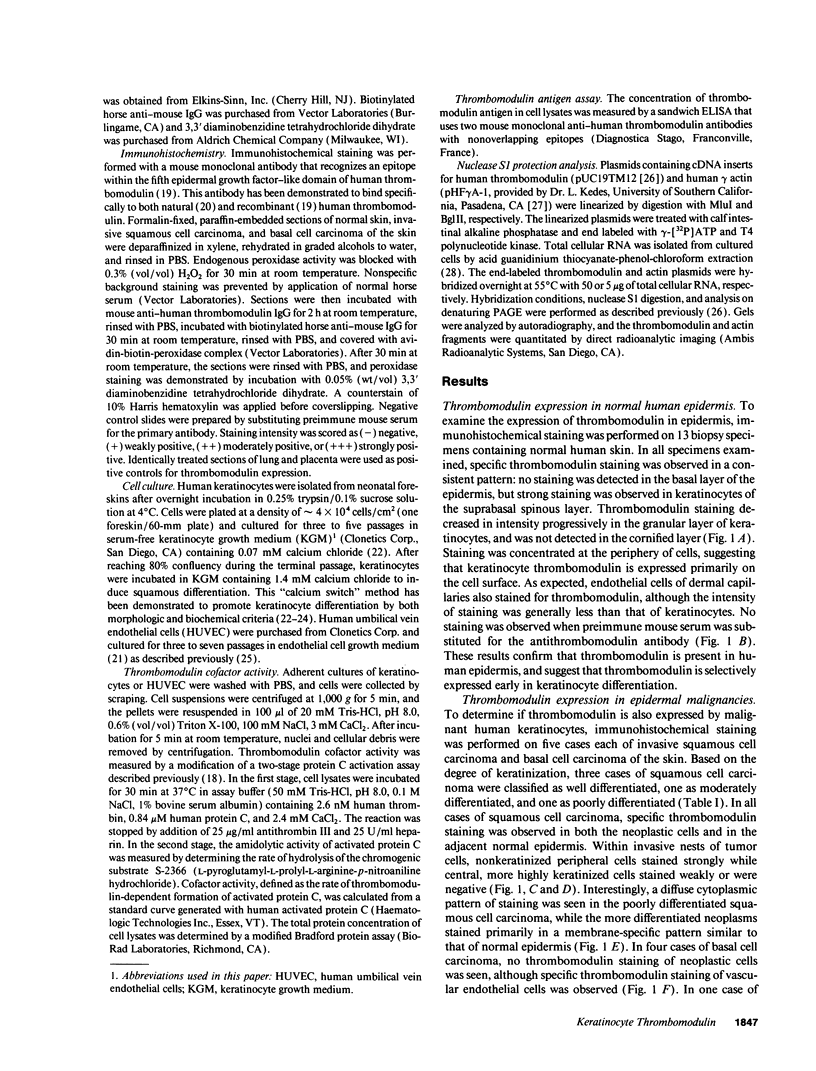
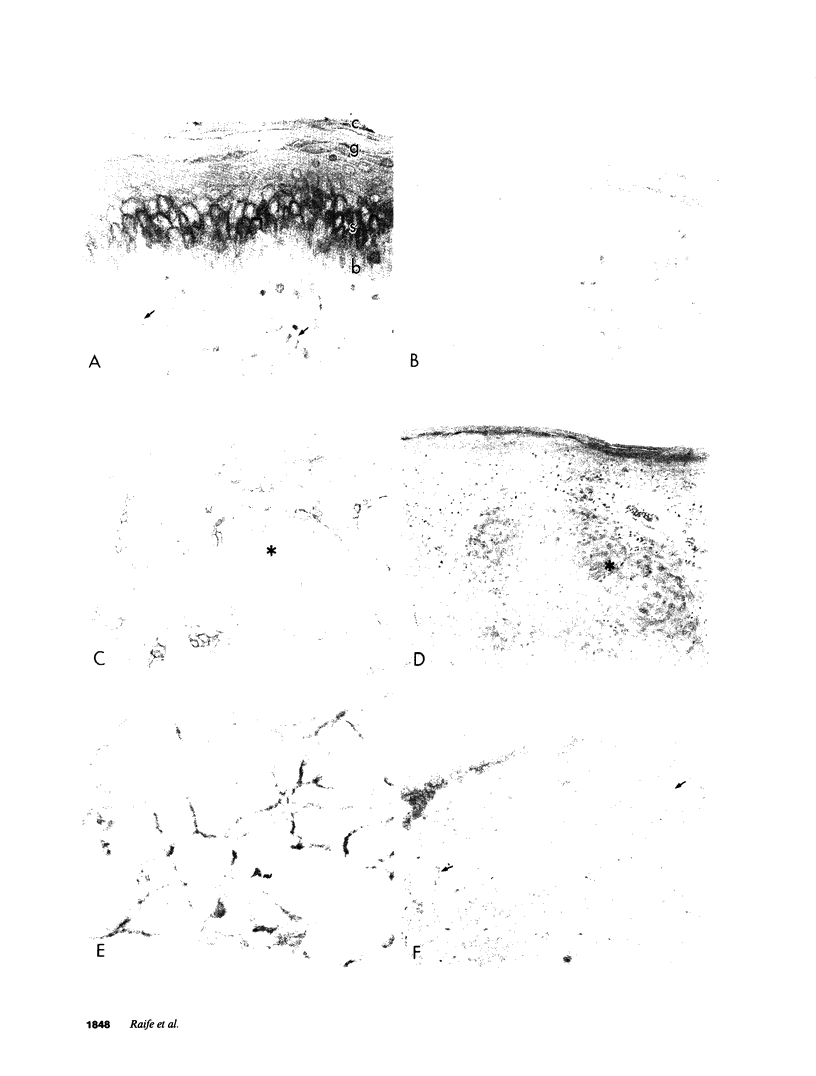
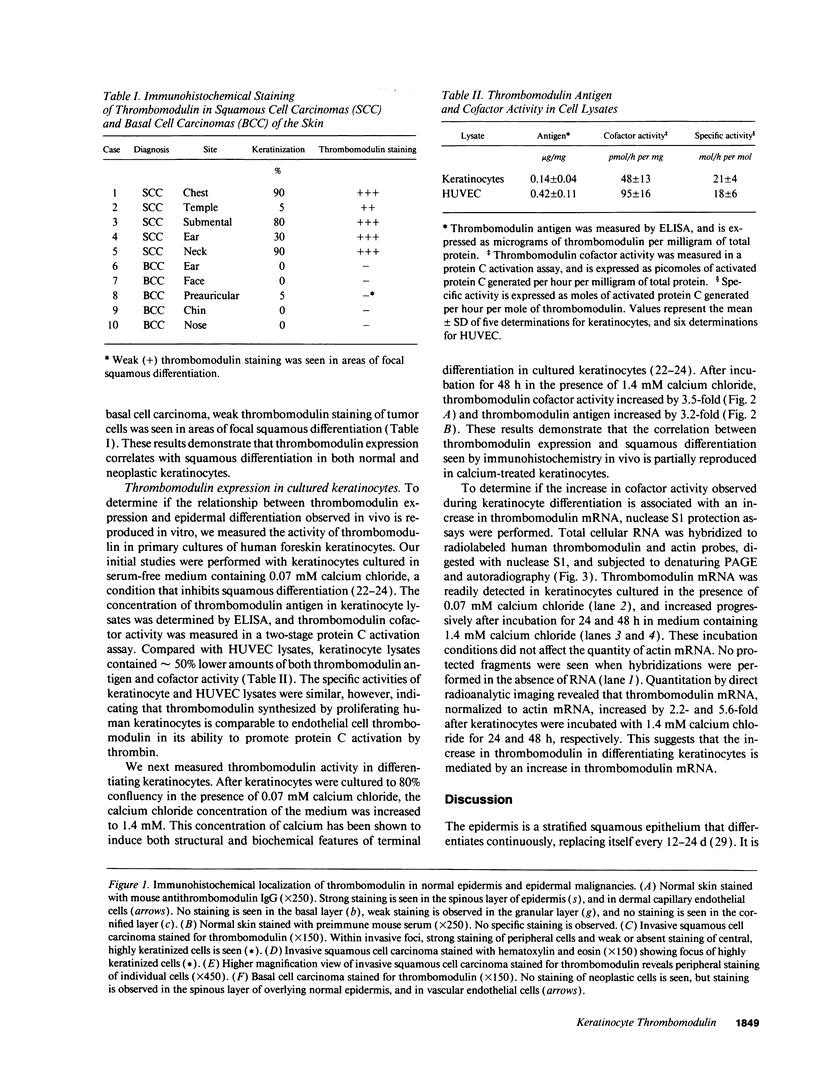
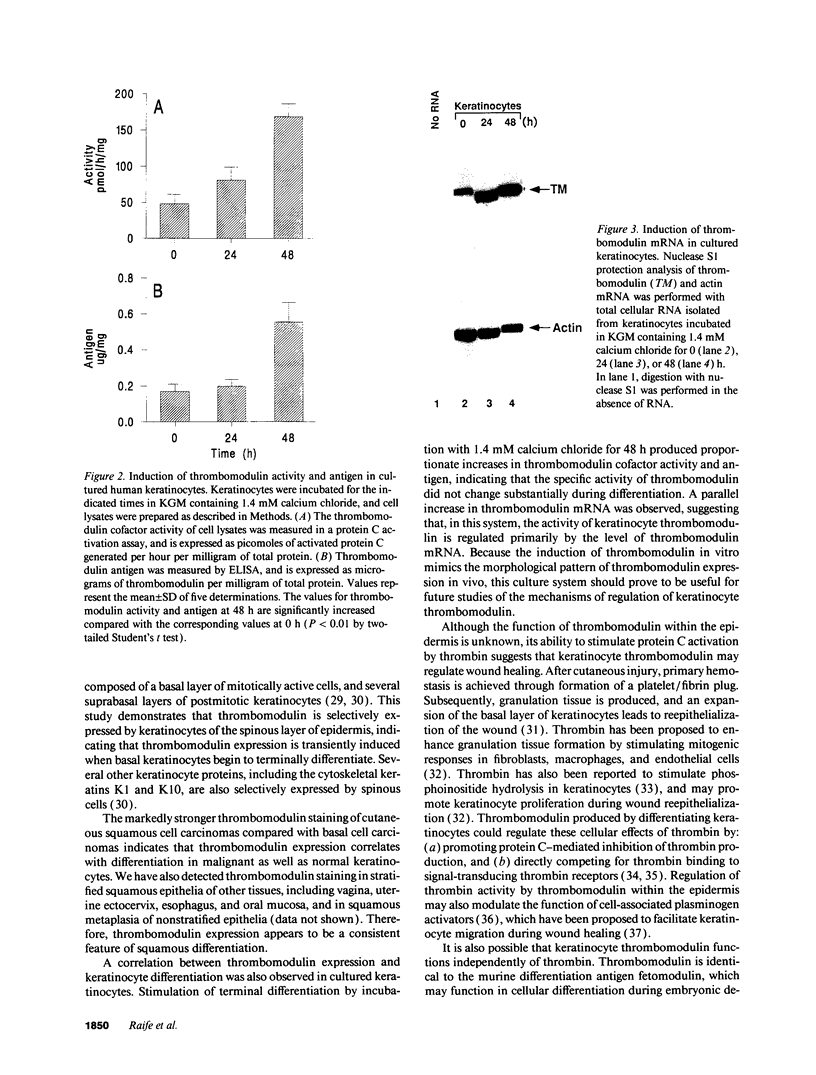
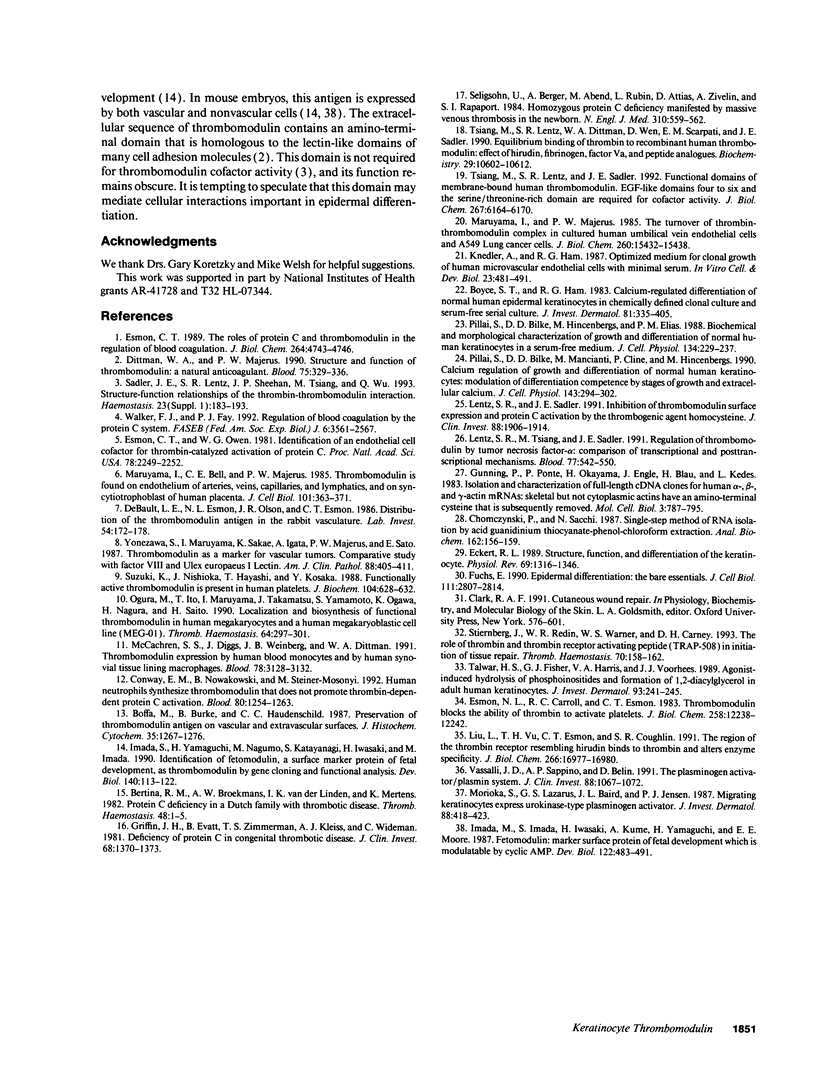
Images in this article
Selected References
These references are in PubMed. This may not be the complete list of references from this article.
- Bertina R. M., Broekmans A. W., van der Linden I. K., Mertens K. Protein C deficiency in a Dutch family with thrombotic disease. Thromb Haemost. 1982 Aug 24;48(1):1–5. [PubMed] [Google Scholar]
- Boffa M. C., Burke B., Haudenschild C. C. Preservation of thrombomodulin antigen on vascular and extravascular surfaces. J Histochem Cytochem. 1987 Nov;35(11):1267–1276. doi: 10.1177/35.11.2821107. [DOI] [PubMed] [Google Scholar]
- Chomczynski P., Sacchi N. Single-step method of RNA isolation by acid guanidinium thiocyanate-phenol-chloroform extraction. Anal Biochem. 1987 Apr;162(1):156–159. doi: 10.1006/abio.1987.9999. [DOI] [PubMed] [Google Scholar]
- Conway E. M., Nowakowski B., Steiner-Mosonyi M. Human neutrophils synthesize thrombomodulin that does not promote thrombin-dependent protein C activation. Blood. 1992 Sep 1;80(5):1254–1263. [PubMed] [Google Scholar]
- DeBault L. E., Esmon N. L., Olson J. R., Esmon C. T. Distribution of the thrombomodulin antigen in the rabbit vasculature. Lab Invest. 1986 Feb;54(2):172–178. [PubMed] [Google Scholar]
- Dittman W. A., Majerus P. W. Structure and function of thrombomodulin: a natural anticoagulant. Blood. 1990 Jan 15;75(2):329–336. [PubMed] [Google Scholar]
- Eckert R. L. Structure, function, and differentiation of the keratinocyte. Physiol Rev. 1989 Oct;69(4):1316–1346. doi: 10.1152/physrev.1989.69.4.1316. [DOI] [PubMed] [Google Scholar]
- Esmon C. T., Owen W. G. Identification of an endothelial cell cofactor for thrombin-catalyzed activation of protein C. Proc Natl Acad Sci U S A. 1981 Apr;78(4):2249–2252. doi: 10.1073/pnas.78.4.2249. [DOI] [PMC free article] [PubMed] [Google Scholar]
- Esmon C. T. The roles of protein C and thrombomodulin in the regulation of blood coagulation. J Biol Chem. 1989 Mar 25;264(9):4743–4746. [PubMed] [Google Scholar]
- Esmon N. L., Carroll R. C., Esmon C. T. Thrombomodulin blocks the ability of thrombin to activate platelets. J Biol Chem. 1983 Oct 25;258(20):12238–12242. [PubMed] [Google Scholar]
- Fuchs E. Epidermal differentiation: the bare essentials. J Cell Biol. 1990 Dec;111(6 Pt 2):2807–2814. doi: 10.1083/jcb.111.6.2807. [DOI] [PMC free article] [PubMed] [Google Scholar]
- Griffin J. H., Evatt B., Zimmerman T. S., Kleiss A. J., Wideman C. Deficiency of protein C in congenital thrombotic disease. J Clin Invest. 1981 Nov;68(5):1370–1373. doi: 10.1172/JCI110385. [DOI] [PMC free article] [PubMed] [Google Scholar]
- Gunning P., Ponte P., Okayama H., Engel J., Blau H., Kedes L. Isolation and characterization of full-length cDNA clones for human alpha-, beta-, and gamma-actin mRNAs: skeletal but not cytoplasmic actins have an amino-terminal cysteine that is subsequently removed. Mol Cell Biol. 1983 May;3(5):787–795. doi: 10.1128/mcb.3.5.787. [DOI] [PMC free article] [PubMed] [Google Scholar]
- Imada M., Imada S., Iwasaki H., Kume A., Yamaguchi H., Moore E. E. Fetomodulin: marker surface protein of fetal development which is modulatable by cyclic AMP. Dev Biol. 1987 Aug;122(2):483–491. doi: 10.1016/0012-1606(87)90312-5. [DOI] [PubMed] [Google Scholar]
- Imada S., Yamaguchi H., Nagumo M., Katayanagi S., Iwasaki H., Imada M. Identification of fetomodulin, a surface marker protein of fetal development, as thrombomodulin by gene cloning and functional assays. Dev Biol. 1990 Jul;140(1):113–122. doi: 10.1016/0012-1606(90)90058-q. [DOI] [PubMed] [Google Scholar]
- Knedler A., Ham R. G. Optimized medium for clonal growth of human microvascular endothelial cells with minimal serum. In Vitro Cell Dev Biol. 1987 Jul;23(7):481–491. doi: 10.1007/BF02628418. [DOI] [PubMed] [Google Scholar]
- Lentz S. R., Sadler J. E. Inhibition of thrombomodulin surface expression and protein C activation by the thrombogenic agent homocysteine. J Clin Invest. 1991 Dec;88(6):1906–1914. doi: 10.1172/JCI115514. [DOI] [PMC free article] [PubMed] [Google Scholar]
- Lentz S. R., Tsiang M., Sadler J. E. Regulation of thrombomodulin by tumor necrosis factor-alpha: comparison of transcriptional and posttranscriptional mechanisms. Blood. 1991 Feb 1;77(3):542–550. [PubMed] [Google Scholar]
- Liu L. W., Vu T. K., Esmon C. T., Coughlin S. R. The region of the thrombin receptor resembling hirudin binds to thrombin and alters enzyme specificity. J Biol Chem. 1991 Sep 15;266(26):16977–16980. [PubMed] [Google Scholar]
- Maruyama I., Bell C. E., Majerus P. W. Thrombomodulin is found on endothelium of arteries, veins, capillaries, and lymphatics, and on syncytiotrophoblast of human placenta. J Cell Biol. 1985 Aug;101(2):363–371. doi: 10.1083/jcb.101.2.363. [DOI] [PMC free article] [PubMed] [Google Scholar]
- Maruyama I., Majerus P. W. The turnover of thrombin-thrombomodulin complex in cultured human umbilical vein endothelial cells and A549 lung cancer cells. Endocytosis and degradation of thrombin. J Biol Chem. 1985 Dec 15;260(29):15432–15438. [PubMed] [Google Scholar]
- McCachren S. S., Diggs J., Weinberg J. B., Dittman W. A. Thrombomodulin expression by human blood monocytes and by human synovial tissue lining macrophages. Blood. 1991 Dec 15;78(12):3128–3132. [PubMed] [Google Scholar]
- Morioka S., Lazarus G. S., Baird J. L., Jensen P. J. Migrating keratinocytes express urokinase-type plasminogen activator. J Invest Dermatol. 1987 Apr;88(4):418–423. doi: 10.1111/1523-1747.ep12469754. [DOI] [PubMed] [Google Scholar]
- Ogura M., Ito T., Maruyama I., Takamatsu J., Yamamoto S., Ogawa K., Nagura H., Saito H. Localization and biosynthesis of functional thrombomodulin in human megakaryocytes and a human megakaryoblastic cell line (MEG-01). Thromb Haemost. 1990 Oct 22;64(2):297–301. [PubMed] [Google Scholar]
- Pillai S., Bikle D. D., Hincenbergs M., Elias P. M. Biochemical and morphological characterization of growth and differentiation of normal human neonatal keratinocytes in a serum-free medium. J Cell Physiol. 1988 Feb;134(2):229–237. doi: 10.1002/jcp.1041340208. [DOI] [PubMed] [Google Scholar]
- Pillai S., Bikle D. D., Mancianti M. L., Cline P., Hincenbergs M. Calcium regulation of growth and differentiation of normal human keratinocytes: modulation of differentiation competence by stages of growth and extracellular calcium. J Cell Physiol. 1990 May;143(2):294–302. doi: 10.1002/jcp.1041430213. [DOI] [PubMed] [Google Scholar]
- Sadler J. E., Lentz S. R., Sheehan J. P., Tsiang M., Wu Q. Structure-function relationships of the thrombin-thrombomodulin interaction. Haemostasis. 1993 Mar;23 (Suppl 1):183–193. doi: 10.1159/000216927. [DOI] [PubMed] [Google Scholar]
- Seligsohn U., Berger A., Abend M., Rubin L., Attias D., Zivelin A., Rapaport S. I. Homozygous protein C deficiency manifested by massive venous thrombosis in the newborn. N Engl J Med. 1984 Mar 1;310(9):559–562. doi: 10.1056/NEJM198403013100904. [DOI] [PubMed] [Google Scholar]
- Stiernberg J., Redin W. R., Warner W. S., Carney D. H. The role of thrombin and thrombin receptor activating peptide (TRAP-508) in initiation of tissue repair. Thromb Haemost. 1993 Jul 1;70(1):158–162. [PubMed] [Google Scholar]
- Suzuki K., Nishioka J., Hayashi T., Kosaka Y. Functionally active thrombomodulin is present in human platelets. J Biochem. 1988 Oct;104(4):628–632. doi: 10.1093/oxfordjournals.jbchem.a122523. [DOI] [PubMed] [Google Scholar]
- Talwar H. S., Fisher G. J., Harris V. A., Voorhees J. J. Agonist-induced hydrolysis of phosphoinositides and formation of 1,2-diacylglycerol in adult human keratinocytes. J Invest Dermatol. 1989 Aug;93(2):241–245. doi: 10.1111/1523-1747.ep12277581. [DOI] [PubMed] [Google Scholar]
- Tsiang M., Lentz S. R., Dittman W. A., Wen D., Scarpati E. M., Sadler J. E. Equilibrium binding of thrombin to recombinant human thrombomodulin: effect of hirudin, fibrinogen, factor Va, and peptide analogues. Biochemistry. 1990 Nov 27;29(47):10602–10612. doi: 10.1021/bi00499a005. [DOI] [PubMed] [Google Scholar]
- Tsiang M., Lentz S. R., Sadler J. E. Functional domains of membrane-bound human thrombomodulin. EGF-like domains four to six and the serine/threonine-rich domain are required for cofactor activity. J Biol Chem. 1992 Mar 25;267(9):6164–6170. [PubMed] [Google Scholar]
- Vassalli J. D., Sappino A. P., Belin D. The plasminogen activator/plasmin system. J Clin Invest. 1991 Oct;88(4):1067–1072. doi: 10.1172/JCI115405. [DOI] [PMC free article] [PubMed] [Google Scholar]
- Walker F. J., Fay P. J. Regulation of blood coagulation by the protein C system. FASEB J. 1992 May;6(8):2561–2567. doi: 10.1096/fasebj.6.8.1317308. [DOI] [PubMed] [Google Scholar]
- Yonezawa S., Maruyama I., Sakae K., Igata A., Majerus P. W., Sato E. Thrombomodulin as a marker for vascular tumors. Comparative study with factor VIII and Ulex europaeus I lectin. Am J Clin Pathol. 1987 Oct;88(4):405–411. doi: 10.1093/ajcp/88.4.405. [DOI] [PubMed] [Google Scholar]



